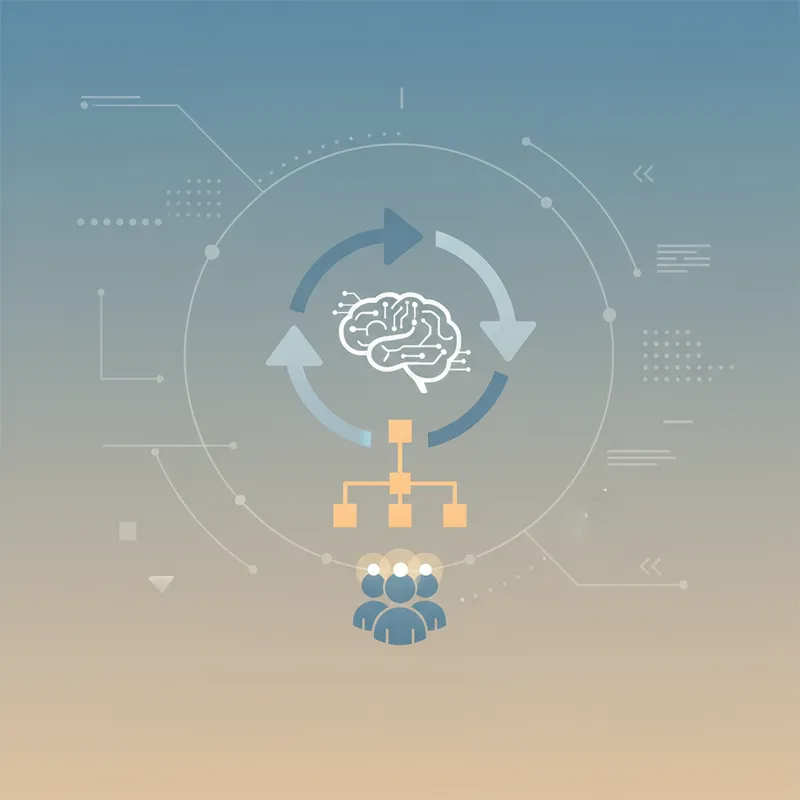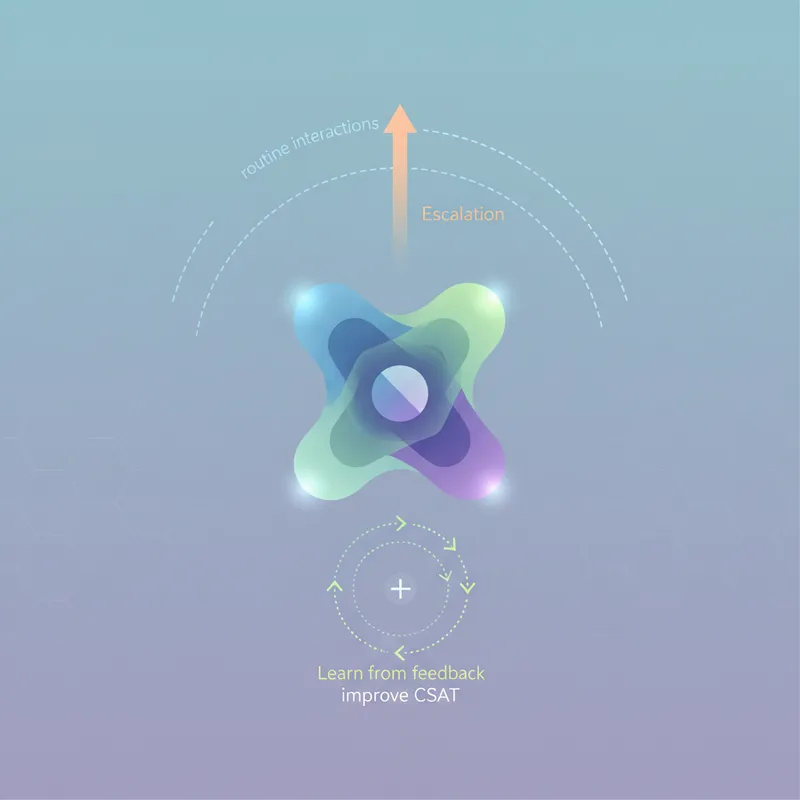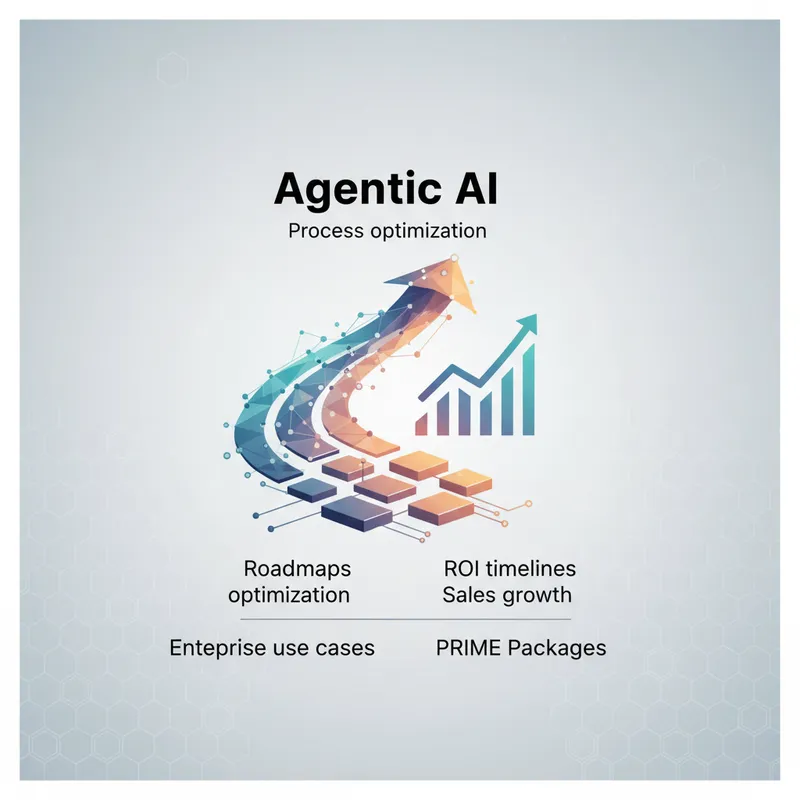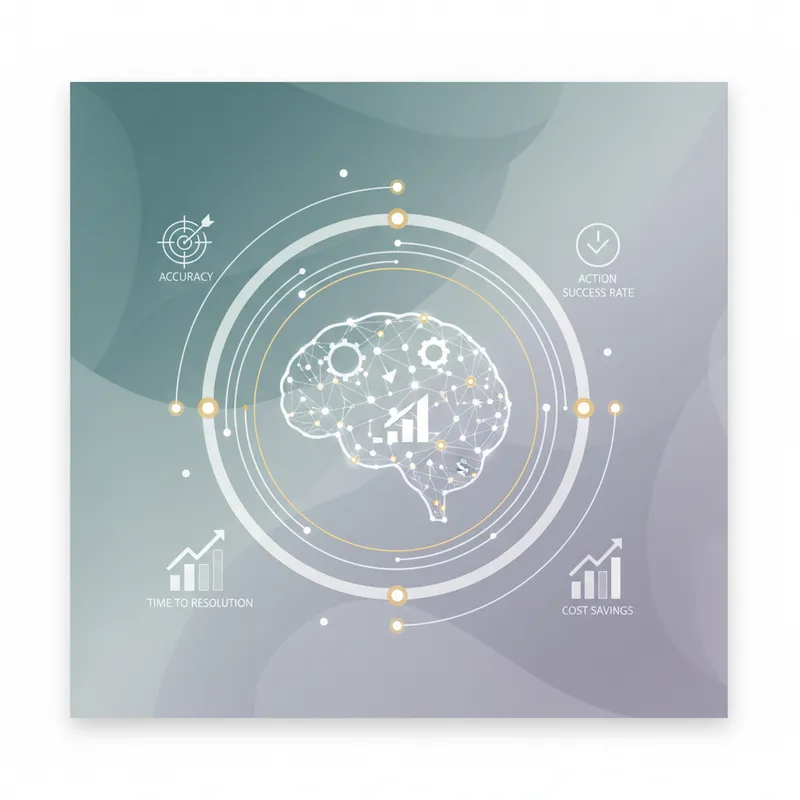
Introduction
Organizations that choose to train employees to work with AI agents gain a strategic advantage in efficiency and innovation. This guide provides a usable curriculum outline and practical change management tips so teams can supervise, audit, and collaborate with autonomous agents with confidence. Training employees to work with AI agents is not only about technical skills. It includes governance, human oversight, prompt design, evaluation methods, and cultural shifts that enable staff to delegate tasks safely and to scale intelligent automation across workflows. Learn more in our post on Future of Work Q3 2025: Agentic AI as the New Operations Layer.
To train employees to work with AI agents effectively, programs must blend hands on practice, scenario based assessment, and ongoing coaching. Leaders need clear roadmaps and measurable outcomes that link agent supervision to business value. This article breaks down a modular curriculum, assessment and certification ideas, a six month implementation roadmap, and change management techniques to accelerate adoption. The objective is to train employees to work with AI agents while preserving accountability, improving quality, and maintaining trust with customers and regulators.
Why Organizations Must Train Employees to Work with AI Agents
AI agents can take on complex tasks across customer service, data analysis, content creation, and process automation. However, without targeted training, employees will either over rely on agents or underutilize them. To train employees to work with AI agents is to empower staff to supervise, correct, and augment agent outputs so outcomes align with business goals. Training reduces risk, improves throughput, and increases employee satisfaction when staff see AI as an assistant not a replacement. Learn more in our post on CEO Guide: Overcoming the Gen-AI Paradox with Agentic AI.
Research shows that while many companies invest in AI, only a small percentage reach full maturity because leaders do not move quickly enough to integrate human workflows with AI. A program to train employees to work with AI agents addresses that gap by developing practical skills and leadership behaviors that accelerate safe adoption. Training should be role specific and scenario driven so employees can immediately apply learning to day to day tasks.
Investing in training to train employees to work with AI agents also creates a foundation for governance. Employees who understand common failure modes, how to audit outputs, and how to report anomalies become part of a feedback loop that improves agent performance over time. That feedback is essential to manage model drift and to keep outputs aligned with policy and ethics requirements.
Core Principles for a Training Program
Before designing curricula, leaders should set guiding principles that will shape how to train employees to work with AI agents. These principles include human in the loop, measured risk tolerance, and continuous learning. When programs emphasize human oversight, employees understand they are accountable for outcomes and are trained to intervene when needed. Learn more in our post on Building Autonomous AI Agents for Customer Service Automation.
Another principle is role based learning. Different roles require different competencies to train employees to work with AI agents. For example, frontline staff need skills in prompt design and validation while auditors require sampling and explainability techniques. Tailoring content ensures relevance and faster adoption.
Finally, programs should be iterative and data driven. Establishing metrics up front allows organizations to measure how well they train employees to work with AI agents and to adjust the curriculum based on performance, error rates, and user feedback.
Curriculum Outline: Foundational Module
Module 1: Introduction to AI Agents
This foundational module explains concepts, capabilities, and limitations. Learners will understand different agent types, basic architecture, and typical use cases. Training employees to work with AI agents starts with clarity about where agents add value and where human judgment remains necessary.
Core lessons include:
- What AI agents are and how they differ from static automation
- Common strengths and weaknesses of agent outputs
- Case studies showing successful human agent partnerships
Outcomes for this module are comprehension based. Employees should be able to describe an agent workflow and identify scenarios where human review is required to maintain quality and compliance. This is the first step to training employees to work with AI agents with the right expectations.
Module 2: Prompting and Instruction Design
Effective prompting is a core skill when you train employees to work with AI agents. This module teaches techniques for clear instruction, context provisioning, and iterative refinement. Learners practice converting business tasks into precise prompts and templates that agents can execute reliably.
Training exercises include role playing and A B testing of prompt variants. Criteria for success emphasize clarity, minimal ambiguity, and reproducibility of results. These exercises teach employees how to craft prompts that reduce error rates and improve output consistency when they work with AI agents.
Module 3: Human Oversight and Intervention
Human oversight training focuses on when to trust an agent and when to intervene. Learners study decision thresholds, escalation paths, and manual correction workflows. Practical scenarios demonstrate how to monitor agent decisions and step in for exceptions.
To train employees to work with AI agents in oversight roles, provide checklists and decision aids that guide real time intervention. This builds confidence and ensures accountability in agent supported tasks.
Curriculum Outline: Auditing, Evaluation, and Safety
Module 4: Output Auditing and Quality Assurance
Auditing skills are essential to train employees to work with AI agents in roles where quality is critical. This module covers sampling strategies, statistical validation, and error taxonomy. Employees learn to design audits that detect systematic biases, hallucinations, and compliance gaps.
Hands on labs let learners apply audit frameworks to agent outputs across different scenarios. Employees practice creating remediation plans and tracking improvements. This module also teaches how to report findings in a way that drives engineering or policy changes.
Module 5: Explainability and Documentation
Training employees to work with AI agents effectively includes understanding model explainability. This module covers techniques to extract rationales, log decisions, and translate technical artifacts into human readable explanations. Employees learn to document agent assumptions and limitations.
Documentation practices create traceability that supports audits and customer inquiries. Teaching staff to produce concise explanations improves transparency and trust in agent enabled services.
Module 6: Privacy, Security, and Compliance
Regulatory and privacy concerns require specific training to train employees to work with AI agents. This module covers data handling, redaction, and consent. Learners review role specific policies and practice scenarios where sensitive data may appear in agent interactions.
Compliance exercises include simulated incidents and reporting drills. Employees learn which data to exclude from prompts and how to escalate suspected breaches. This reduces legal risk when teams incorporate agents into business workflows.

Curriculum Outline: Advanced and Role Specific Tracks
Module 7: Agent Engineering Basics for Non Engineers
Many employees who will collaborate with AI agents are not engineers. This track teaches the basics of agent configuration, version control, and testing without heavy code. Training employees to work with AI agents in technical coordination roles reduces dependency on engineering teams.
Topics include validating configuration changes, interpreting logs, and coordinating releases. Learners practice running lightweight tests and creating rollback plans. The goal is to enable non engineers to contribute to agent lifecycle activities safely.
Module 8: Data Stewardship and Labeling
Quality training data is critical. This module teaches employees how to manage labeled data, spot annotation errors, and maintain datasets used to fine tune agents. Training employees to work with AI agents includes understanding how data quality influences model behavior.
Exercises emphasize labeling consistency, bias detection, and building feedback loops from audits. Employees learn to prioritize data fixes that yield the greatest performance improvement.
Module 9: Leadership and Governance for Managers
Managers need training to set policy, measure impact, and lead change. This governance track teaches how to define KPIs, create oversight committees, and balance innovation with risk management. To train employees to work with AI agents at scale, managers must be fluent in both technical constraints and organizational processes.
Leadership exercises include stakeholder mapping, budget planning, and scenario based risk assessments. Leaders learn how to sponsor pilot programs and scale successful approaches across teams.
Change Management Tips to Support Training
Change management is essential to help employees adopt new ways to train and to supervise AI agents. Start by aligning training goals to clear business outcomes. When organizations train employees to work with AI agents, they should show how agent collaboration will improve measurable metrics such as response time, error rate, or throughput.
Use champions and peer coaches who demonstrate practical uses. Peer led sessions help to normalize agent collaboration and reduce fear. Champions can share quick wins and common pitfalls to make it easier to train employees to work with AI agents across diverse teams.
Communication is critical. Provide simple, repeated messages about where agents will be used, what responsibilities remain with humans, and how success will be measured. Transparent communication avoids mixed expectations and makes it easier to train employees to work with AI agents without undermining trust.
- Start small with pilots that target high impact use cases and train employees to work with AI agents in those contexts.
- Measure early by tracking adoption, accuracy, and time saved to show value and refine training content.
- Provide support channels such as office hours, internal forums, and escalation paths to help employees learn when they train employees to work with AI agents.
Practical Training Techniques and Exercises
Active learning accelerates adoption when you train employees to work with AI agents. Combine short lectures with hands on labs where participants build prompts, review outputs, and document anomalies. Use realistic datasets and typical business scenarios so learners encounter the same edge cases they will face in production.
Role play exercises are particularly useful. Have one participant act as an agent and another as a human supervisor to practice escalation and intervention. These simulations make it easier to embed behaviors that will be used daily when teams train employees to work with AI agents.
Include deliberate practice sessions where learners receive targeted feedback on prompts, audit samples, and decision thresholds. Iterative feedback helps employees internalize patterns and reduces repeating common mistakes. When teams train employees to work with AI agents in a supported environment, confidence and quality both improve.

Assessment, Certification, and Continuous Learning
Assessment frameworks ensure that when you train employees to work with AI agents the learning sticks. Use a mix of knowledge checks, practical assessments, and live observation. Practical assessments should require learners to complete end to end tasks such as creating a prompt, validating outputs, and documenting an audit finding.
Certification can be tiered by role. For example, a basic certification verifies prompt design and oversight skills while an advanced certificate confirms auditing and governance competencies. Certifications should be time bound and require periodic renewal to reflect changing agent capabilities.
Continuing education is essential because models, features, and regulations change. Create short refresher modules and monthly knowledge shares so employees maintain their ability to work with AI agents. Internal newsletters and a searchable best practices repository keep lessons current and accessible for teams who train employees to work with AI agents.
Metrics and KPIs to Track Success
Define outcome focused metrics to evaluate training effectiveness. Typical KPIs include reduction in agent error rates, time saved on tasks, escalation frequency, and audit pass rates. When you train employees to work with AI agents focus on both usage metrics and quality metrics to ensure adoption does not sacrifice accuracy.
Other useful indicators are employee confidence scores, mean time to detect anomalies, and the proportion of tasks successfully automated with human oversight. These metrics help teams prioritize further training or tooling investments as they scale agent collaboration.
Regularly review KPIs with stakeholders and use them to adapt the curriculum. When you train employees to work with AI agents, data driven iteration closes the loop between learning and operational performance.
Implementation Roadmap: A Six Month Sample Plan
Below is a practical six month plan to train employees to work with AI agents. The roadmap balances rapid value with risk control and continuous improvement.
- Month 1 Pilot Design: Identify pilot use cases, establish KPIs, design the foundational and oversight modules, and recruit pilot participants. Train employees to work with AI agents in a controlled environment and define success criteria.
- Month 2 Pilot Execution: Run the pilot with hands on sessions and live support. Collect audit samples and feedback to refine prompts and oversight rules. Continue to train employees to work with AI agents through coaching and checklists.
- Month 3 Evaluation and Scale Prep: Assess pilot results against KPIs. Update training materials, build a certification track, and prepare tooling for broader roll out. Reinforce lessons to train employees to work with AI agents at scale.
- Month 4 Phased Roll Out: Expand to additional teams with targeted modules, deploy champions, and schedule certification exams. Monitor early adopters and provide rapid support to sustain progress when you train employees to work with AI agents across functions.
- Month 5 Optimization: Use audit data to prioritize model and data improvements. Update curriculum based on real world issues and add role specific labs to train employees to work with AI agents in specialized contexts.
- Month 6 Governance and Continuous Learning: Formalize governance processes, refresher courses, and scheduled audits. Establish a feedback loop between operations, data teams, and training to continuously improve how teams train employees to work with AI agents.
Key success factors are leadership sponsorship, measurement, and cross functional collaboration. When you train employees to work with AI agents with a sensible roadmap, you reduce risk and accelerate value realization.
Technology and Tooling Considerations
Selecting the right tooling can make it far easier to train employees to work with AI agents. Look for platforms that provide audit logs, versioning, sandbox environments, and role based access control. These features support safe experimentation and effective oversight.
Integrations with existing workflows reduce friction. To train employees to work with AI agents effectively, provide connectors to collaboration tools, ticketing systems, and knowledge bases so agents can operate within established processes. Tooling should also expose explainability features to support audits and user trust.
Ensure that tooling supports data redaction and privacy controls. When teams train employees to work with AI agents, platform capabilities that prevent sensitive data from being sent to agents reduce compliance burden and help employees follow policy.

Common Challenges and How to Overcome Them
Resistance to change is common when you train employees to work with AI agents. Address it by communicating benefits in terms that matter to employees such as reduced mundane work and more time for high impact tasks. Use champions to model good behavior and to build early advocates.
Quality consistency is another challenge. Solve it by standardizing prompts, building templates, and creating checklists. Regular audits and fast feedback loops make it possible to catch regressions quickly after you train employees to work with AI agents.
Legal and ethical concerns must be proactively managed. Involve legal, compliance, and privacy teams early in curriculum design. Training employees to work with AI agents should include scenario based legal training and clarity on data handling to reduce organizational risk.
Scaling the Program Across the Organization
Scaling requires repeatable processes and modular content. Create bite sized modules that can be reassembled for different roles. Use a train the trainer approach to multiply reach so that experienced employees can teach peers how to train employees to work with AI agents in diverse parts of the business.
Automate where possible. For example, use learning management systems to track certifications and to deliver continuous updates. When you train employees to work with AI agents, embed micro learning snacks that reinforce key practices and that are easy to consume between tasks.
Governance must scale too. Establish clear ownership of agent performance, incident response, and audit responsibilities so accountability remains clear even as adoption grows. This helps sustain high quality outcomes as you train employees to work with AI agents in many teams.
Return on Investment and Business Impact
Quantifying ROI helps justify investment in programs to train employees to work with AI agents. Track time saved, error reduction, customer satisfaction improvements, and throughput increases. Tie these metrics to financial impact such as cost savings or revenue uplift.
Case studies and internal success stories are powerful. Share examples where teams trained employees to work with AI agents and realized measurable improvements. Demonstrating clear business outcomes accelerates buy in from leadership and helps secure funding for expanded training.
Final Recommendations and Next Steps
Start with a clear pilot that addresses a high value, low risk use case. Build a modular curriculum that blends hands on practice with governance and auditing. Prioritize role based learning to ensure relevance and faster adoption. Use metrics to iterate and to demonstrate impact so that you can scale training programs to train employees to work with AI agents across the organization.
Invest in tooling that supports audit logs, explainability, and sandbox testing. Appoint champions and create regular forums for knowledge sharing. Finally, treat training as ongoing. AI agents evolve and policies change. A continuous learning approach ensures that when you train employees to work with AI agents they remain capable, confident, and aligned with business and regulatory expectations.
Conclusion
Training employees to work with AI agents is a strategic priority that requires planning, measurement, and sustained investment. Effective programs combine foundational knowledge, role specific skills, and governance training so employees can supervise, audit, and collaborate with agents safely. When organizations train employees to work with AI agents, they reduce operational risk, improve quality, and unlock productivity gains that compound over time.
Implementation should follow a roadmap that begins with targeted pilots and expands through phased roll outs. To train employees to work with AI agents successfully, leaders must define clear KPIs, provide real world practice, and create certification pathways that instill confidence and accountability. Change management matters as much as technical content. Clear communication, visible champions, and practical support channels help people move from curiosity to competence when they train employees to work with AI agents.
Ongoing assessment and continuous learning keep skills current as models and regulations evolve. Audit mechanisms and explainability practices ensure that outputs from AI agents meet quality and compliance standards. By embedding human oversight and establishing fast feedback loops, organizations can iterate on agent performance and maintain trust with customers and regulators as they train employees to work with AI agents.
In summary, a well designed program to train employees to work with AI agents balances speed with safety. It starts small, focuses on measurable outcomes, and scales through modular content and strong governance. With the right approach, training empowers people to partner with AI agents and to deliver better, faster, and more reliable outcomes for the business and for customers.



